Harvard Management Co. is dead. Long live Harvard Management Co.
After a decade of low returns and high turnover, the group responsible for managing Harvard University’s $37 billion endowment is beginning anew. Ushering in this era is chief executive officer Nirmal (Narv) Narvekar, an Ivy League endowment alum who joined in December to tackle what he calls the “deep structural problems” plaguing Harvard’s investment office.
The appointment signaled major changes for Harvard Management Co., which for years had operated under its signature hybrid model of internally and externally managed assets. That was unique among university endowments, which on average invest about 4 percent of assets in-house, according to Cathy Konicki, head of consulting firm NEPC’s endowment and foundation practice.
“Harvard was an anomaly,” she says. But no longer.
Not even a year into his tenure, Narvekar has dismantled asset management teams at the endowment in favor of outsourcing its investments to external managers. By the time the CEO is through with his planned five-year transformation, Harvard Management Co. will more closely resemble peers such as Narvekar’s former employer, Columbia Investment Management Co. — and the hybrid model will be all but dead.
“You’ve seen an acceptance among endowments and not-for-profits more broadly that unless you’re a really sizable investment portfolio, the ability to do a lot of things in-house is really challenging,” says Kevin Quirk, principal at Casey Quirk, a Deloitte-owned consulting firm. “The amount of necessary resources, the compensation, and just the general capital market challenges make it increasingly difficult to be successful,” he says.
Harvard Management Co. had begun reducing its internal investing before Narvekar arrived, including downsizing its in-house equities team in the spring of 2016, but the final nail in the coffin was a dismal fiscal 2016 — a 2 percent loss in a year when the average endowment lost money but rival Yale University’s fund still gained 3.4 percent. The poor performance coincided with the resignation of Stephen Blyth, Harvard Management Co.’s third CEO within ten years, who stepped down after two months of medical leave.
One week after releasing the endowment’s 2016 investment results, the university announced the hire of Narvekar from Columbia University, where he had worked for 14 years.
As CEO of Columbia’s $9 billion endowment, Narvekar took a Yale-like approach, investing heavily in private markets and other alternatives through allocations to external managers. His staff numbered around 20 — less than a tenth of the size of Harvard Management Co.’s then-230-person team.
Within two months of starting his new job, Narvekar announced plans in a January letter addressed to “members of the Harvard community” to slash his workforce in half, give the remaining investment staff broader, more “generalist” roles, and develop new investment and risk frameworks.
Narvekar further laid out plans to eliminate Harvard Management Co.’s internal hedge-fund teams by the end of the fiscal year and spin out the endowment’s direct real-estate team as an external manager before 2018. Only the natural-resources team, focusing on investments in timber and agriculture, was to be kept in-house.
“While I don’t expect a large portion of the portfolio to be managed internally as a practical matter,” Narvekar wrote, “nothing is out of bounds in the future.” Ten months into his role, Harvard Management Co.’s new chief executive has already made good on some of those promises.
As of June 30, he had shut down the endowment’s internally managed equities and relative-value investments, according to its fiscal year report, which came in the form of another letter from Narvekar. The CEO wrote in September that both Harvard Management Co.’s internal credit platform — run by Rene Canezin — and direct real-estate group are still expected to spin out as external managers, and that two of the relative-value teams would likely continue to invest the endowment’s assets as external partners.
According to a person familiar with the matter, one of these teams includes former Harvard Management Co. portfolio managers Michele Toscani and Graig Fantuzzi, who departed the endowment in June to start their own relative-value firm, TPRV Capital. At least three other Harvard staffers — Robert Bennett, Vitaly Shatkovsky, and Nick VanMeter — left with Toscani and Fantuzzi, and now serve as portfolio managers at TPRV, according to their LinkedIn pages.
“Harvard is pretty unique as an institutional investor in terms of creating what ultimately become successful third-party managers themselves,” Quirk says. Long-time chief Jack Meyer, for example, ultimately left the endowment to set up hedge fund Convexity Capital Management, Quirk adds, pointing to other high-profile examples such as Highfields Capital Management, the hedge fund co-founded by Harvard cub Jonathon Jacobson and best known for its role in exposing Enron Corp.’s accounting fraud.
As for the staff remaining at Harvard, Narvekar emphasized in his September letter the importance of changing its culture to one that is collaborative rather than hierarchical. So far, the CEO has taken steps in that direction by moving away from the endowment’s old “silo” system — in which investment professionals focused on specific asset classes — to the generalist format. This year he also has brought on a new CIO — Rick Slocum, from a family office in New York City called the Johnson Co. — and three new managing directors, all Ivy League endowment alumni from Columbia or the University of Pennsylvania, where Narvekar honed his investing approach.
“Ultimately, we seek to develop a partnership culture in which colleagues can easily access one another and engage in informal debate,” Narvekar wrote in the letter.
Under his leadership, Harvard Management Co. has a new compensation framework. Except for the remaining in-house teams, including the natural-resources group, the endowment’s staff will now be paid based on total portfolio performance, rather than the returns of a single asset class or sub-portfolio. They will be compensated based on five-year performance, with executive and senior team members receiving bonuses over a multi-year period.
“The program is designed to allow HMC to attract and retain top endowment talent,” Narvekar said in the letter.
The CEO has also created a new risk framework, which he said will replace Harvard’s former asset-allocation approach. The new model will subject return-seeking to a risk-tolerance level set by the university with the recommendations of the endowment’s board of directors. Asset allocation will be based on risk exposures, with commitments framed not as a number of dollars but as a portion of portfolio risk.
As part of its change in strategy, Harvard Management Co. has spent this year unloading around $2.5 billion in assets, says the person familiar with the matter. This has included a deal to sell $1.6 billion in real-estate investments to Landmark Partners and almost $1 billion in private-equity assets to secondary investment firm Lexington Partners, the person says.
In fiscal 2017 — only the second half of which was overseen by Narvekar — Harvard’s endowment gained 8.1 percent, a “disappointing” result far behind endowment peers the Massachusetts Institute of Technology and Dartmouth College, which produced gains of more than 14 percent.
“There is certainly much work to be done,” Narvekar said in the letter. “I am confident that our efforts will ultimately result in a stronger model and improved investment performance that will benefit many future generations of Harvard students, faculty, and staff to come.”







